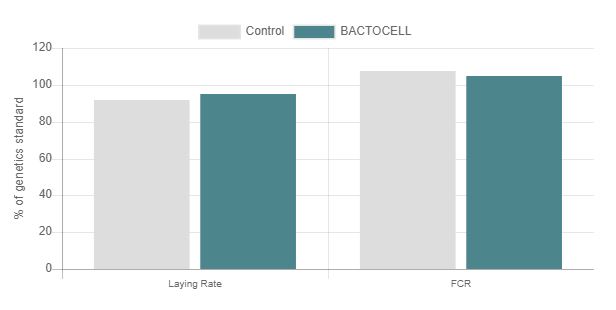Blog | Reading Time 2 minutes
Using probiotics to manage poultry feed costs
Energy is a major driver of feed costs in poultry production. Nutritionists formulate the diet depending on the potential laying capacity of the breed, the hen’s age, the egg production target, and the costs of available raw materials. It is estimated that, in poultry, 5 to 30% of the total energy requirement is provided by the gut microbiota. Recent findings confirm that BACTOCELL — Pediococcus acidilactici CNCM I-4622 (MA 18/5M) — represents an additional tool to manage ration costs for poultry production.
Energy compensation
Mikulski et al. (2020) conducted a study to determine the effect of P. acidilactici supplementation in diets with different energy levels on laying hen performance.
Despite a 100 kcal ME/kg of feed difference, the probiotic/low energy group displayed a similar laying rate, equivalent feed conversion rate, and exported egg mass than the control/ standard energy group. The researchers concluded that the probiotic was able to compensate for the effect of a 100 kcal ME/ kg of feed energy dilution on the laying performance.
This research suggests the probiotic supplement exerts a positive influence on dietary energy utilization. The publication concluded that P. acidilactici CNCM I-4622 supplementation on a reduced-energy diet can be a viable strategy for lowering feed costs while maintaining laying performance and egg quality.
Improved performance
Moreover, it appears hens fed the probiotic diet have better performance than hens without the probiotic (P<0.05) when comparing the effect of the probiotic with an equivalent diet at the same energy level. This is consistent with the scientific and field performance knowledge gathered during the last 20 years of P. acidilactici CNCM I-4622 usage in laying hens. Overall, there is a 3% increase in egg production and a 2.7% improvement in feed conversion (Figure 2) (Demey et al., 2018).
Feeding strategies
The new findings show P. acidilactici CNCM I-4622 brings egg producers another tool to manage ration costs by improving dietary energy utilization. Laying hens will extract more energy from the feed. This gives nutritionists two options:
- Use the probiotics on top of the formula to improve overall performance
- Use P. acidilactici CNCM I-4622 to reduce the cost of energetic raw material (30- 50 kcal/kg of feed depending on the performance targeted)
Published Oct 12, 2020 | Updated Jun 7, 2023
Related articles
Need specific information?
Talk to an expert